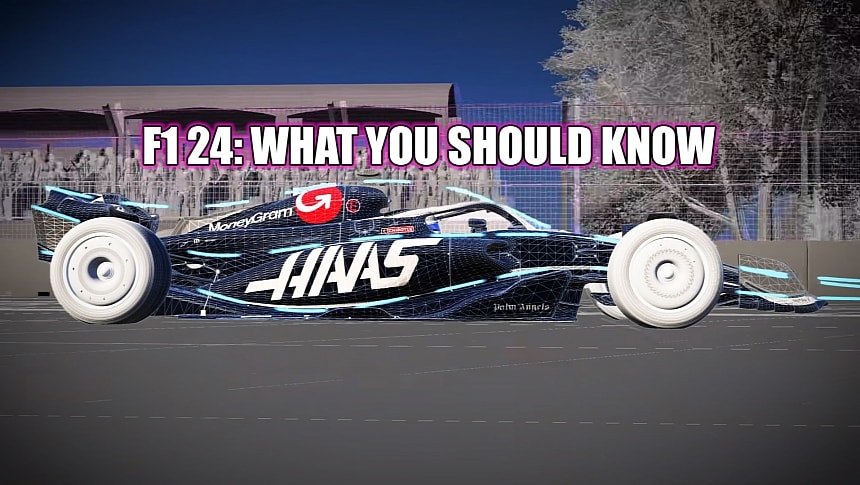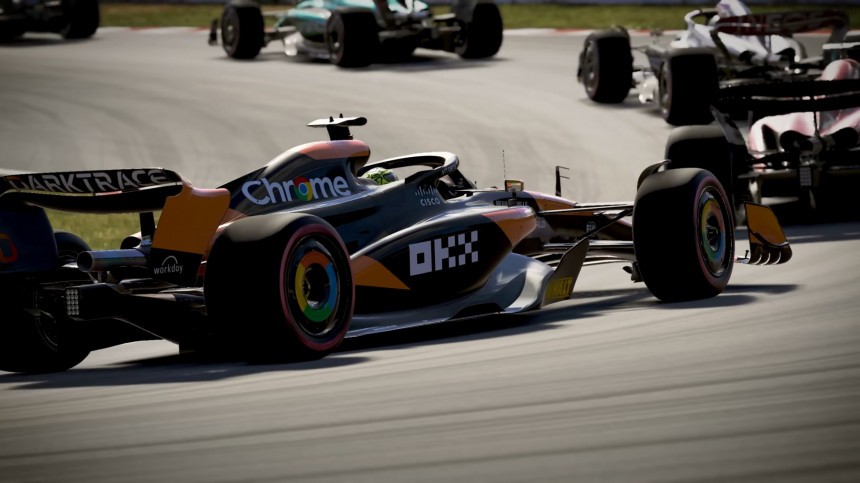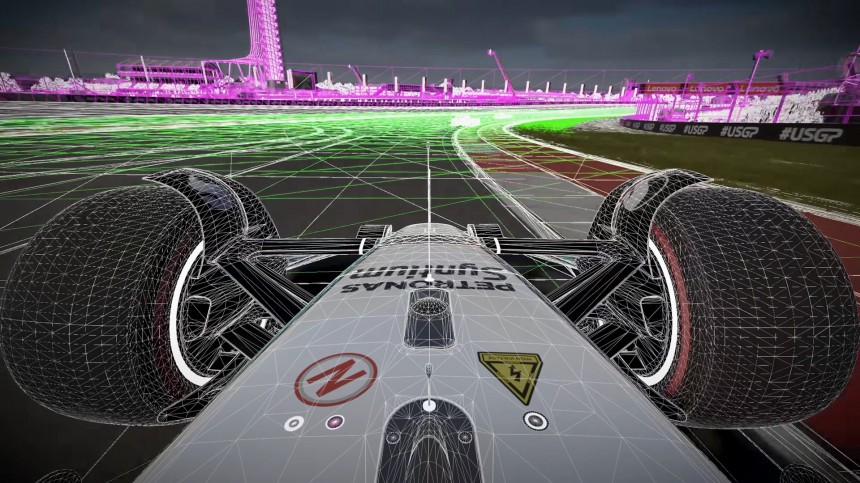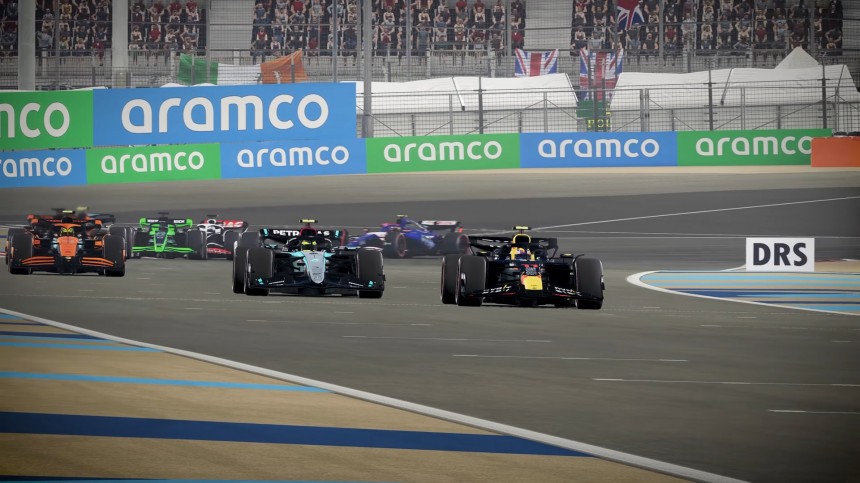Developer Codemasters uses a lot of fancy words when bragging about how they "revolutionized" F1 24 and implicitly the series by adding and changing a great deal of gameplay systems. F1 24 is coming out on May 31 and costs $70 for the Standard version or 90 bucks for the Champions Edition. However, you get a 15% discount if you own F1 2021, F1 22, or F1 23.
Some of these bold "Shakespearean" quotes sound a little bit like this: "In addition to revolutionary tire and suspension updates, we've reworked the cars' aerodynamics to add a new layer of realism." My favorite line is, "We've reworked the slipstreaming model using Computation Fluid Dynamics," because it sounds like a '90s movie where they're "hacking into the mainframe."
All joking aside, let's see precisely what EA SPORTS says they did to F1 24 and how the upcoming iteration sets itself apart from the rest of the series using "the largest-ever physics update with EA SPORTS DYNAMIC HANDLING," EA's supposedly most immersive driving experience yet.
The dynamic handling system was born from a collaboration between the Codemasters studio and Max Verstappen himself. The purpose was to rework the feeling of the F1 car so players could experience a more true-to-life immersion.
The new suspension kinematics system should offer a more realistic weight distribution and center of gravity. The forces acting on the springs and dampers have gone through an overhaul, which should provide a dynamic sense of handling involving the weight of the car and the style of driving itself.
In translation, the lighter or heavier the vehicle, the more you'll have to adapt in corners. This involves the suspension system, which you must tweak depending on the track layout, thus achieving a balance between stability in high-speed sections and more traction at low speeds.
Directly related to the handling system is the improved tire model. Temperature is now a key part of tire behavior, which sounds pretty cool, at least as advertised. The brand-new temperature model has variations involving the carcass and surface temperature differences due to tire pressure, weather, and track conditions, but most importantly, your driving style that seems to be at the center of all these gameplay changes.
If you're driving too aggressively and go to town on the brakes, especially in dirty air on a hot summer's day, you'll suffer more structural rubber damage, as opposed to adopting a smoother driving style in opposite track circumstances. The dynamic weather system is integral to the experience as well. If a race starts out dry and hot, but along the way, it starts pouring, you can cool your tires and prologue their short life by driving onto wet portions of the track.
The aerodynamic model was updated in areas like the suspension system and tires. Most importantly, the Computational Fluid Dynamics (CFD) system also got some love from the developers. The CFD helps the forces acting on the car have more realistic effects, such as downforce.
Another great one is the slipstream effect, otherwise known as Ricky Bobby's "Shake & Bake" among Talladega Nights aficionados. You can follow your opponents more closely if you can tail them like an expert. The Drag Reduction System (DRS) has been updated to reflect the drag effect accurately.
The model chassis and floor profiles of the 2024 season cars are more accurate than ever. If you equip your vehicle with special rear wings that enhance the drag effect, you'll sacrifice top speed on the straights, and vice versa, given the opposite circumstances.
You can tweak a lot of performance settings regarding your car, like the aerodynamics, transmission system, suspension geometry, breaks, and tires. Thankfully, the interface seems player-friendly, so it doesn't look like adjusting the simple percentage bars will require an MIT degree.
The throttle has been specially tweaked so that the cars generate more horsepower as you push down the acceleration pedal when you exit a corner. The ERS (Energy Recovery System) helps you manually adjust the energy recovery, which is pretty handy when you take your foot off the pedal, finger off the trigger, or, God forbid... finger off the W key if you're playing old-school from a keyboard.
Apparently, there was a very popular demand to bring back the option to swap between ERS modes on the fly in every race weekend session, so out of the goodness of their hearts, EA SPORTS put it back in F1 24. This will have a "mini-game" effect where you keep an eye on the ERS icon to ensure your car's system is doing what it should be.
Whether all this is true or not, enthusiasts will find out when the game comes out and subsequently let the rest of the world know if F1 24's gameplay is really as good as it sounds or if the marketing department is better than the game itself. The Standard edition F1 24 costs $70 and includes the F1 World Starter Pack, 5,000 PitCoins (virtual currency), and the Dual Entitlement feature which activates the game for both last and current-gen consoles.
The $90 Champions Edition includes a VIP Podium Pass, two new My Team Icons, F1 World Bumper Pack, 18,000 PitCoins, and the Dual Entitlement. There are also some benefits for F1 23 owners, but the cherry on top is that Champions will play it three days early.
It's a shame they don't do Activision-Blizzard style Early Access where you can play your special edition seven days earlier in cases like Call of Duty: Modern Warfare. Three days doesn't do much for working people who barely have one or two hours per day for gaming.
All joking aside, let's see precisely what EA SPORTS says they did to F1 24 and how the upcoming iteration sets itself apart from the rest of the series using "the largest-ever physics update with EA SPORTS DYNAMIC HANDLING," EA's supposedly most immersive driving experience yet.
The dynamic handling system was born from a collaboration between the Codemasters studio and Max Verstappen himself. The purpose was to rework the feeling of the F1 car so players could experience a more true-to-life immersion.
In translation, the lighter or heavier the vehicle, the more you'll have to adapt in corners. This involves the suspension system, which you must tweak depending on the track layout, thus achieving a balance between stability in high-speed sections and more traction at low speeds.
Directly related to the handling system is the improved tire model. Temperature is now a key part of tire behavior, which sounds pretty cool, at least as advertised. The brand-new temperature model has variations involving the carcass and surface temperature differences due to tire pressure, weather, and track conditions, but most importantly, your driving style that seems to be at the center of all these gameplay changes.
If you're driving too aggressively and go to town on the brakes, especially in dirty air on a hot summer's day, you'll suffer more structural rubber damage, as opposed to adopting a smoother driving style in opposite track circumstances. The dynamic weather system is integral to the experience as well. If a race starts out dry and hot, but along the way, it starts pouring, you can cool your tires and prologue their short life by driving onto wet portions of the track.
Another great one is the slipstream effect, otherwise known as Ricky Bobby's "Shake & Bake" among Talladega Nights aficionados. You can follow your opponents more closely if you can tail them like an expert. The Drag Reduction System (DRS) has been updated to reflect the drag effect accurately.
The model chassis and floor profiles of the 2024 season cars are more accurate than ever. If you equip your vehicle with special rear wings that enhance the drag effect, you'll sacrifice top speed on the straights, and vice versa, given the opposite circumstances.
You can tweak a lot of performance settings regarding your car, like the aerodynamics, transmission system, suspension geometry, breaks, and tires. Thankfully, the interface seems player-friendly, so it doesn't look like adjusting the simple percentage bars will require an MIT degree.
Apparently, there was a very popular demand to bring back the option to swap between ERS modes on the fly in every race weekend session, so out of the goodness of their hearts, EA SPORTS put it back in F1 24. This will have a "mini-game" effect where you keep an eye on the ERS icon to ensure your car's system is doing what it should be.
Whether all this is true or not, enthusiasts will find out when the game comes out and subsequently let the rest of the world know if F1 24's gameplay is really as good as it sounds or if the marketing department is better than the game itself. The Standard edition F1 24 costs $70 and includes the F1 World Starter Pack, 5,000 PitCoins (virtual currency), and the Dual Entitlement feature which activates the game for both last and current-gen consoles.
The $90 Champions Edition includes a VIP Podium Pass, two new My Team Icons, F1 World Bumper Pack, 18,000 PitCoins, and the Dual Entitlement. There are also some benefits for F1 23 owners, but the cherry on top is that Champions will play it three days early.
It's a shame they don't do Activision-Blizzard style Early Access where you can play your special edition seven days earlier in cases like Call of Duty: Modern Warfare. Three days doesn't do much for working people who barely have one or two hours per day for gaming.





































